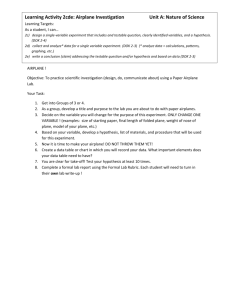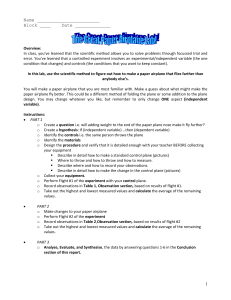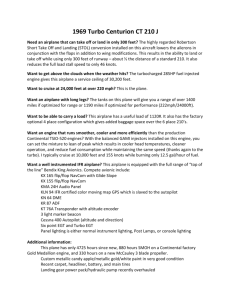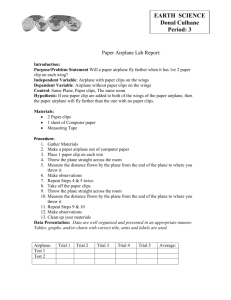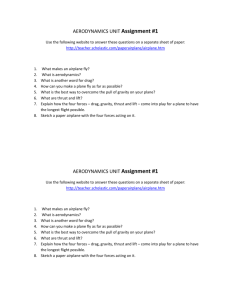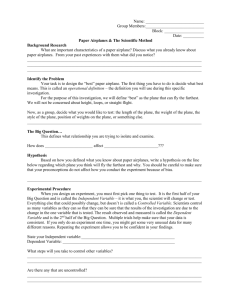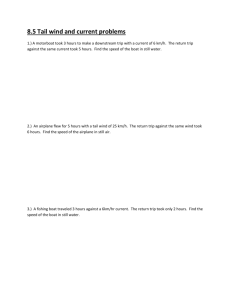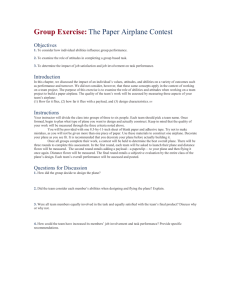the study of how far different paper airplanes
advertisement
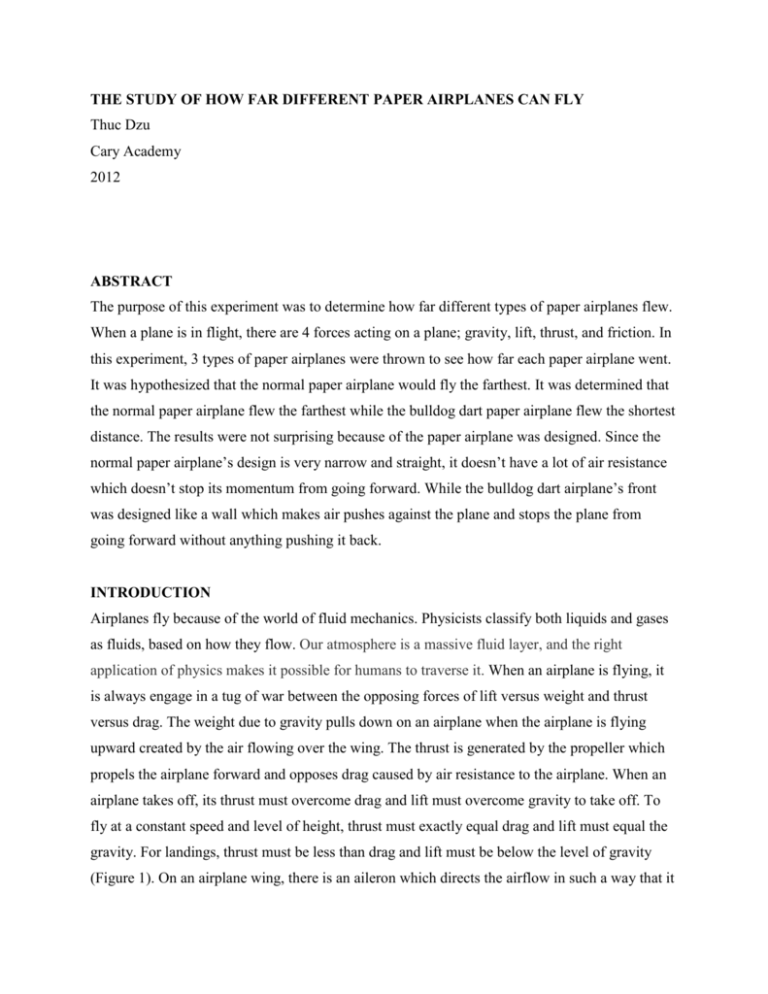
THE STUDY OF HOW FAR DIFFERENT PAPER AIRPLANES CAN FLY Thuc Dzu Cary Academy 2012 ABSTRACT The purpose of this experiment was to determine how far different types of paper airplanes flew. When a plane is in flight, there are 4 forces acting on a plane; gravity, lift, thrust, and friction. In this experiment, 3 types of paper airplanes were thrown to see how far each paper airplane went. It was hypothesized that the normal paper airplane would fly the farthest. It was determined that the normal paper airplane flew the farthest while the bulldog dart paper airplane flew the shortest distance. The results were not surprising because of the paper airplane was designed. Since the normal paper airplane’s design is very narrow and straight, it doesn’t have a lot of air resistance which doesn’t stop its momentum from going forward. While the bulldog dart airplane’s front was designed like a wall which makes air pushes against the plane and stops the plane from going forward without anything pushing it back. INTRODUCTION Airplanes fly because of the world of fluid mechanics. Physicists classify both liquids and gases as fluids, based on how they flow. Our atmosphere is a massive fluid layer, and the right application of physics makes it possible for humans to traverse it. When an airplane is flying, it is always engage in a tug of war between the opposing forces of lift versus weight and thrust versus drag. The weight due to gravity pulls down on an airplane when the airplane is flying upward created by the air flowing over the wing. The thrust is generated by the propeller which propels the airplane forward and opposes drag caused by air resistance to the airplane. When an airplane takes off, its thrust must overcome drag and lift must overcome gravity to take off. To fly at a constant speed and level of height, thrust must exactly equal drag and lift must equal the gravity. For landings, thrust must be less than drag and lift must be below the level of gravity (Figure 1). On an airplane wing, there is an aileron which directs the airflow in such a way that it helps the airplane turn. On an airplane tail, there are 2 elevators which help it go up or down. There is also the rudder which actually turns the airplane. Inside of the airplane, there is the pedal which a pilot presses to turn the rudder and there is the control column which controls the elevators. There are many types of airplanes and wings with it. Different airplanes are used for different purposes. Lift Thrust Friction Gravity Figure 1. This diagram shows what forces are acting on a plane when the plane is in flight. Friction is the force that resists the relative solid surfaces, fluid layers, and material elements sliding against each other. There are several types of frictions: Dry friction, Fluid friction, Lubricated friction, Skin friction and Internal friction. Dry friction resists relative lateral motion of 2 solid surfaces in contact. Fluid friction describes the friction between layers within a viscous fluid that are moving relative to each other. Lubricated friction is a case of fluid friction where a fluid friction separates 2 solid surfaces. Skin friction is a component of drag, the force resisting the motion of a solid body through a fluid. Internal friction is the force resisting motion between the elements making up a solid material while it undergoes deformation. When an airplane is flying through the air fluid friction and other forces are acting upon it. Again, fluid friction occurs between layers within a fluid that are moving relative to each other. This internal resistance is described by viscosity. In normal circumstances, viscosity means thickness. The name aerodynamics is a combination of the Greek terms aer, meaning “air,” and dynamis, meaning “power.” Aerodynamics is the study of air and other gases. It also includes the study of the interaction of air with moving objects. Aerodynamics is the science that explains how airplanes can fly. The secret of flight lies in the plane’s wings. Airplanes experience a lot of drag or air resistance in the air, so airplanes have to be designed as smooth and are streamlined to make air go around them easier. The wings are specially designed to make the airplane go up. Wings are designed with a special shape. When air flows past this shape, it is accelerated downward. The force of this air movement acting downward is accompanied by an equal and opposite upward, which follows the Newton's third law. If the air flows fast enough, the airplane will have enough lift to support it in the air. Gravity is a natural phenomenon. It is the force that makes an object fall to the ground when dropped. Gravity is responsible for keeping Earth and other planets orbiting the sun. Gravity is one of the 4 fundamental interactions of nature. The other 3 are electromagnetism and the nuclear strong force and weak force. In the very beginning of the universe, after the Big bang, gravity pulled all matter and atoms together to create planets, stars and other things. After the planets and stars were created, gravity kept the planets in orbit around the stars. Nobody fully understands gravity or why gravity even exists. The paper airplane is a toy aircraft. It is usually a glider that is made out of paper or paperboard. The practice of constructing paper airplanes is called aerogami after origami the Japanese art of folding paper. Ancient China is believed to have created the paper airplane because of the major paper industry. Pioneers studied paper airplanes hoping to make the same thing but on a more massive scale. In time, designers have changed and improved the paper airplane. Sam Stanforth, from Cary Academy, has studied how different types of paper airplanes can stay in the air when thrown at the wind. He would do this by making paper airplanes from an airplane book then waiting for the wind to push against the airplane. Afterwards, he would throw the plane and start a timer. When the plane hit the ground, he would stop the timer and do this again. He would do this 3 times with each paper airplane and take an average. MATERIALS AND METHODS Printer papers, water, beaker, eye dropper, meter sticks, duct tape, and timer were used in the experiments. In the first experiment, 3 different types of paper airplanes were thrown to see which one flew the farthest. The types of paper airplanes are the normal, Bulldog, and the Deltry airplane. Meter sticks were placed out in the hallway. Duct tape was placed to show where the paper airplane would be thrown from. The paper airplane was then thrown at the same angle and same throwing force. This was done 3 times with each plane and an average was taken. In the follow up experiment, the same paper airplanes were used as the first experiment but the experiment’s purpose was to see which type of airplane stay up the longest. When the plane was thrown, the timer started and when the plane hit the ground, the timer stopped. This was done 3 times with each plane and the average was taken. In the third follow up experiment, 50, 100, and 200 drops of water was added to each wing on the normal paper airplane. The experiment was to see how far the paper airplane flew with a certain amount of water drops. This was done 3 times with each plane and the average was taken. In the third follow up experiment, the same things was done as the experiment above but 10, 20, and 30 drops of water was added to the normal paper airplane. After water was added to the wings, the paper airplane was then left to dry for a day. After a day, the plane was thrown to see how long the plane stayed in the air. This was done 3 times with 3 normal paper airplane and the average was taken. RESULTS AND DISCUSSION In the first experiment the normal paper airplane flew 676.6 cm while the Bulldog Dart paper airplane flew only 588 cm (Figure 2). The normal paper airplane flew the farthest because of the plane design. When the plane was thrown, the thrust was very powerful and as friction occurred on the paper airplane, the way the paper airplane was shaped helped it have the least amount of air resistance. While the bulldog dart’s front part is flat and is like a wall which makes air push against the paper airplane and makes it go slow and doesn’t let the paper airplane go fast or far. How Far the Plane Flew (cm) 800 700 600 500 400 300 200 100 0 Classic Plane Bulldog Dart Deltry Plane Type of Plane Figure 2. This graph shows how far each type of plane flew. In the first follow up experiment, the bulldog dart stayed up in the air for 1.53 seconds while the normal paper airplane stayed in the air for 1.23 seconds (Figure 3). The bulldog dart paper airplane stayed in the air the longest because of its special wing design. As the paper airplane flies, it swings side to side as it balances itself as gravity is pushing down on it. Since the wings are thin and the plane is thin but long, the plane wouldn’t really fly but just be a projectile. But the special way the paper airplane was shaped, made it harder for it to fall. While the normal paper airplane just flew and tried to go as far and stay as straight as possible, since its design is to have the least amount of air resistance, the plane doesn’t have much glide in it. How Long The Plane Stayed In FLight (sec) 1.8 1.6 1.4 1.2 1 0.8 0.6 0.4 0.2 0 Classic Plane Bulldog Dart Deltry Plane Type of Plane Figure 3. This graph shows which paper plane stayed in flight the longest. In the second follow up experiment, 50, 100, and 200 drops of water was added to the paper airplane’s wings and when 50 drops of water was added to the paper airplane’s wing, there was a dramatic change on how far the paper airplane flew. But as more drops of water were added, it started to decrease at a small rate. This happened because as more water was added the paper airplane got heavier and heavier. As this happened, the plane started to lose its form and just be a wet clump of paper. How Far the Plane Flew (cm) 700 600 500 400 300 200 100 0 0 50 100 150 How Many drops of water was added 200 Figure 4. This graph shows how far the normal paper plane flew when 0, 50, 100, and 200 drops of water was added to the plane's wings. In the third follow up experiment, 10, 20, and 30 drops of water was added to each wing on the normal paper airplane and the paper airplane was let alone to dry for a day. When there was no water added, the paper airplane stayed in the air the longest but when 10 drops of water was added, the time dropped dramatically. But as more water was added, the time the paper airplane stayed in the air didn’t change. This happened because as water was added, it changed the form of the paper and when it dried, the part with dried water on it popped up and everything else was fine and flat. In the beginning, when water was added, it changed the form of the wings in a different way so it just couldn’t really fly. But as more water was added, the form started to be the same and so the paper airplane was the same. So that doesn’t change the way the paper How Long The Plane Stayed in Flight (sec) airplane is anymore. 6 5 4 3 2 1 0 0 5 10 15 20 25 30 35 How many Drops of Water Was Added Figure 5. This graph shows how long the normal plane stayed in the air when 0, 10, 20, and 30 drops of water that was then left to dry for a day. CONCLUSION Different types of plane and the different type of wing design affected how the plane flew and how far the plane flew. The above information could be important to people who are planning to make a real airplane and would like to learn the basics off a basic model. The results were suspected based on previous experiments done by Sam Stanforth. In the future, it would be interesting to study how long the bulldog dart stayed in the air when the whole right wing, left wing, bottom of the paper airplane, and front of the paper airplane is dipped into water and then let to dry. CITATIONS "aerodynamics." The American Heritage® New Dictionary of Cultural Literacy, Third Edition. Houghton Mifflin Company, 2005. 15 Feb. 2012. <Dictionary.com "airplane." Compton's by Britannica. Encyclopædia Britannica Online School Edition. Encyclopædia Britannica, Inc., 2012. Web. 8 Feb. 2012. Brain, M.. "how do planes fly." How stuff works. N.p., 2012. Web. 16 Feb 2012. Carr, Karen. "Gravity," Kidipede - History for Kids. 2011. Gaitan, G.. "What Makes An Airplane Fly - Level 1." All star network. Raytheon, 2004. Web. 16 Feb 2012. Iggulden, Conn, and Hal Iggulden. The Dangerous Book For Boys.U.K: HarperCollins Publisher, 2006. Print. Kerrod, Robin, and Dr. Sharon Ann Holgate. The Way Science Works. New York: DK Publishing, 2002. Print. Macaulay, David. The Way Things Work. Boston: Houghton Mifflin, 1988. Print. Mit “Paper Airplanes.” Web 15 Feb. 2012. Wikipedia contributors. "Friction." Wikipedia, The Free Encyclopedia. Wikipedia, The Free Encyclopedia, 15 Feb. 2012. Web. 15 Feb. 2012. Wikipedia contributors. "Gravitation." Wikipedia, The Free Encyclopedia. Wikipedia, The Free Encyclopedia, 4 Feb. 2012. Web. 15 Feb. 2012. Wikipedia contributors. "Paper plane." Wikipedia, The Free Encyclopedia. Wikipedia, The Free Encyclopedia, 31 Dec. 2011. Web. 15 Feb. 2012.
